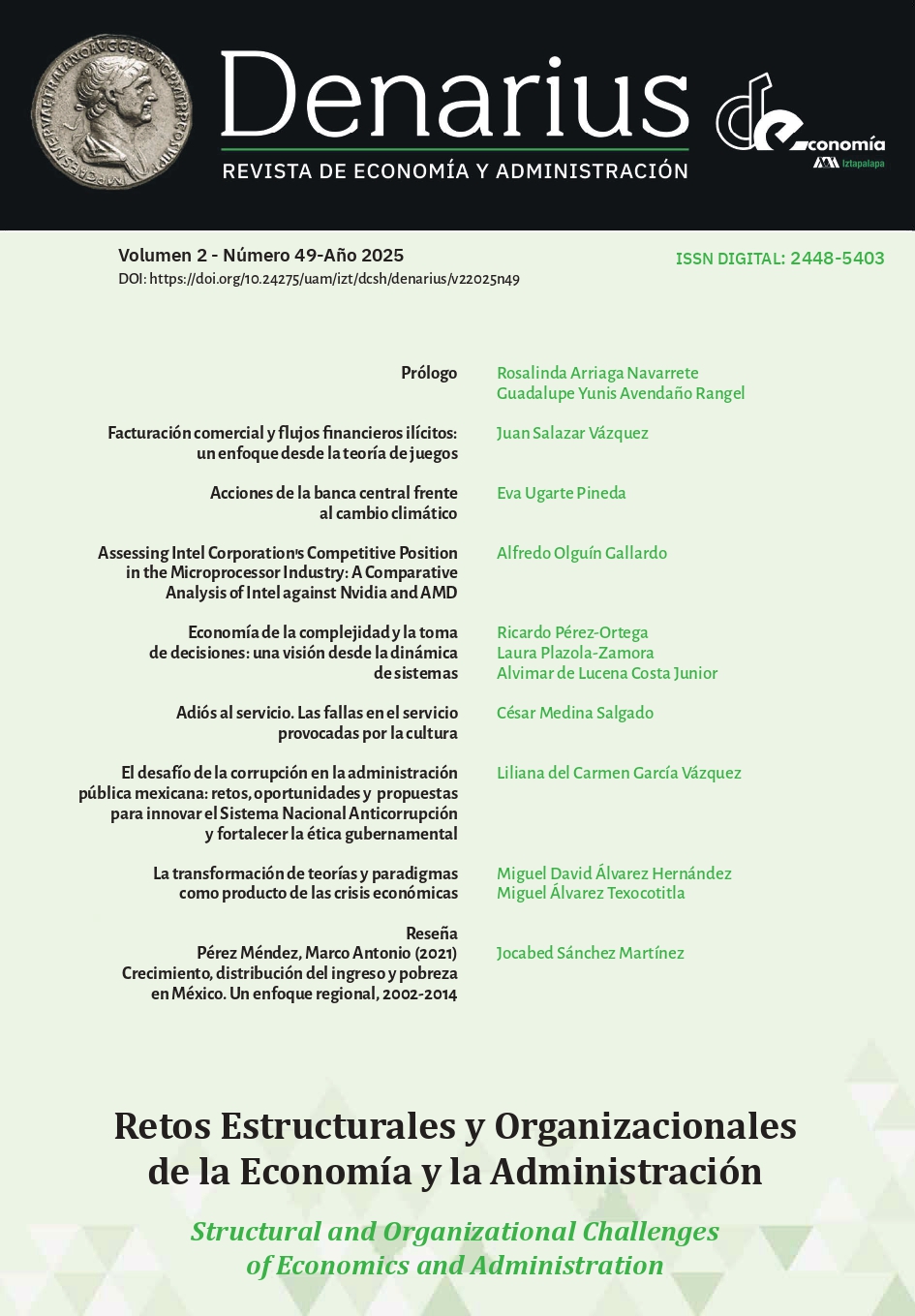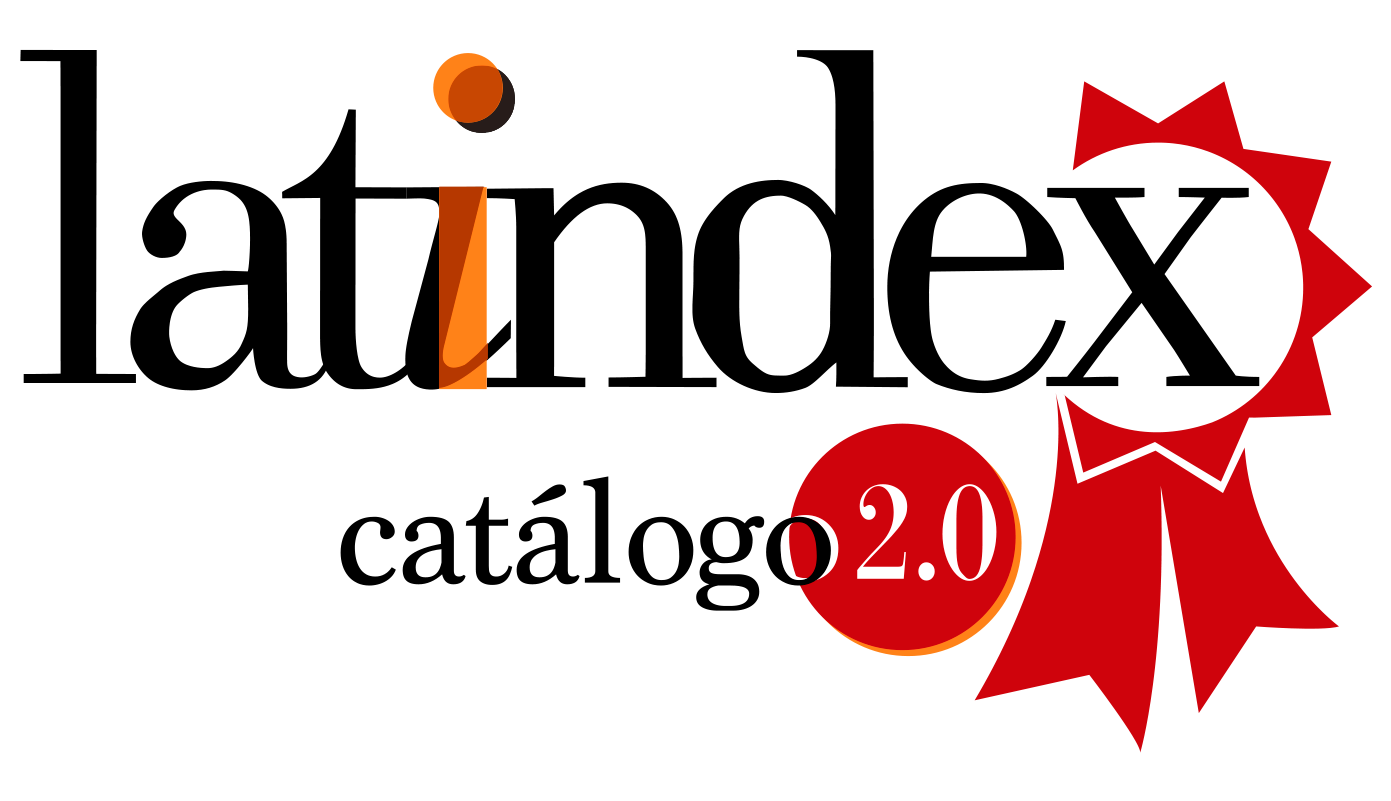Economía de la complejidad y la toma de decisiones: una visión desde la dinámica de sistemas.
Resumen
El objetivo de este estudio es analizar el efecto de la incertidumbre, las emociones y los sistemas cognitivos, modelados como rezagos temporales, sobre la eficiencia del procesamiento de información para la toma de decisiones a lo largo del tiempo. Estos rezagos incrementan la carga cognitiva, lo que limita las capacidades cognitivas y el procesamiento de información del agente. Se desarrolló un modelo de Dinámica de Sistemas basado en la Economía de la Complejidad, Economía Conductual, la Teoría de la Desatención Racional y la Teoría de la Información. Los resultados muestran que los rezagos afectan a todo el sistema, e impiden el procesamiento completo de la información disponible. Se concluye que la eficiencia cognitiva del agente depende de sus capacidades cognitivas, y su adaptación a las fluctuaciones de incertidumbre, flujo emocional y carga cognitiva a través del tiempo.
Descargas
Citas
Abraham, R. H. (1984). COMPLEX DYNAMICAL SYSTEMS. En X. J. R. Avula, R. E. Kalman, A. I. Liapis, & E. Y. Rodin (Eds.), Mathematical Modelling in Science and Technology (pp. 82–86). Pergamon. https://doi.org/10.1016/B978-0-08-030156-3.50020-5
Allen, P. M., Edwards, J. A., Snyder, F. J., Makinson, K. A., & Hamby, D. M. (2014). The Effect of Cognitive Load on Decision Making with Graphically Displayed Uncertainty Information. Risk Analysis, 34(8), 1495–1505. https://doi.org/10.1111/risa.12161
Alvino, L., & Franco, M. (2017). The decision-making process between rationality and emotions. International Journal of scientific research and management, 5(9), 7074–7092. https://doi.org/10.18535/ijsrm/v5i9.18
Anatoliy Tkach, & Tkach, A. (2019). The role of emotions in economic desion-making. Humanities and Social Sciences quarterly, 26(2), 145–155. https://doi.org/10.7862/rz.2019.hss.21
Aracil, J., & Gordillo, F. (1997). Dinámica de sistemas. https://dialnet.unirioja.es/servlet/libro?codigo=216476
Arthur, W. B. (1989). Competing Technologies, Increasing Returns, and Lock-In by Historical Events. Economic Journal, 99(394), 116–131.
Arthur, W. B. (1999). Complexity and the Economy. Science, 284(5411), 107–109.
Arthur, W. B. (2014). Complexity and the Economy.
Arthur, W. B. (2021). Foundations of complexity economics. Nature Reviews Physics, 3(2), Article 2. https://doi.org/10.1038/s42254-020-00273-3
Bah, S., Radzicki, M., & Smith, A. (2023). Bringing Behavioral Economics into System Dynamics: Some Challenges, Solutions, and a Path Forward (pp. 107–135). https://doi.org/10.1007/978-3-031-40635-5_4
Bak, P., Tang, & Wiesenfeld, K. (1987). Self-organized criticality: An explanation of the 1/f noise. PubMed. https://pubmed.ncbi.nlm.nih.gov/10035754/
Balland, P.-A., Broekel, T., Diodato, D., Giuliani, E., Hausmann, R., O’Clery, N., & Rigby, D. (2022). The new paradigm of economic complexity. Research Policy, 51(3), 104450. https://doi.org/10.1016/j.respol.2021.104450
Bertalanffy, L. von. (1950). An Outline of General System Theory. British Journal for the Philosophy of Science, 1(2), 134–165. https://doi.org/10.1093/bjps/i.2.134
Blaywais, R., & Rosenboim, M. (2019). The effect of cognitive load on economic decisions. Managerial and Decision Economics, 40(8), 993–999. https://doi.org/10.1002/mde.3085
Bragger, J. D., Bragger, D., Hantula, D. A., & Kirnan, J. (1998). Hyteresis and Uncertainty: The Effect of Uncertainty on Delays to Exit Decisions. Organizational Behavior and Human Decision Processes, 74(3), 229–253. https://doi.org/10.1006/obhd.1998.2779
Castaneda, G. (2021). The Paradigm of Social Complexity: An Alternative Way of Understanding Societies and their Economies Praise for the book.
Castañeda, G. (2021). The paradigm of complexity. Centro de estudios Espinosa Iglesias.
Castillo, Sanchez, & Venegas. (2010). La modelación económica Una interpretación de la simulación dinámica de sistemas (Primera). Universidad autónoma Metropolitana.
Cavalieri, D. (2017). Complexity in Economics: System Dynamics and Policy Implications. History of Economic Ideas, 25(3), 101–136.
Cavana, Y., Dangerfield, Pavlov, Radzicki, & Wheat. (2021). Feedback Economics: Economic Modeling with System Dynamics (1st ed.). Springer. https://doi.org/10.1002/sdr.1695
Chen, J. (2002). An Entropy Theory of Value. SSRN Electronic Journal. https://doi.org/10.2139/ssrn.307442
Clark, A. (2015). Embodied Prediction. https://www.semanticscholar.org/paper/Embodied-Prediction-Clark/76a1b8a721673417723915845555175f9ed3eef3
Crookes, D. J., & De Wit, M. P. (2014). Is System Dynamics Modelling of Relevance to Neoclassical Economists? South African Journal of Economics, 82(2), 181–192. https://doi.org/10.1111/saje.12038
Dangerfield, B. (2006). A System Dynamics Model for Economic Planning in Sarawak. https://www.semanticscholar.org/paper/A-System-Dynamics-Model-for-Economic-Planning-in-Dangerfield/69d9312f72dd2390502eb7ff97470f93df832d20
Deck, C., & Jahedi, S. (2015). The Effect Of Cognitive Load On Economic Decision Making: A Survey And New Experiments. European Economic Review, 78, 97–119. https://doi.org/10.1016/j.euroecorev.2015.05.004
Devine, S. (2018). An Economy Viewed as a Far-from-Equilibrium System from the Perspective of Algorithmic Information Theory. Entropy, 20(4), Article 4. https://doi.org/10.3390/e20040228
Dooley, K. J. (2022). Complex adaptive systems. En Handbook of Theories for Purchasing, Supply Chain and Management Research (pp. 335–344). Edward Elgar Publishing. https://www.elgaronline.com/edcollchap/book/9781839104503/book-part-9781839104503-26.xml
Drichoutis, A. C., & Nayga, R. M. (2020). Economic rationality under cognitive load. The Economic Journal, 130(632), 2382–2409. https://doi.org/10.1093/ej/ueaa052
Elsner, W. (2017). Complexity Economics as Heterodoxy: Theory and Policy. Journal of Economic Issues, 51(4), 939–978.
Esther‐Mirjam Sent, & Sent, E.-M. (2000). Complexity in Economics. https://doi.org/10.1007/978-3-030-47898-8
Evans, J. St. B. T. (2003). In two minds: Dual-process accounts of reasoning. Trends in Cognitive Sciences, 7(10), 454–459. https://doi.org/10.1016/j.tics.2003.08.012
Faggini, M., & Parziale, A. (Eds.). (2014). Complexity in Economics: Cutting Edge Research. Springer International Publishing. https://doi.org/10.1007/978-3-319-05185-7
Farmer, J. (2012). Economics needs to treat the economy as a complex system. https://www.semanticscholar.org/paper/Economics-needs-to-treat-the-economy-as-a-complex-Farmer/d6ec0cbc2aa6608a0b2b2b3659959df7e61f4b9e
Forrester, J., W. (1961). Industrial Dynamics. MIT Press, Cambridge, Mass.
Gabaix, X. (2018). Behavioral inattention. https://doi.org/10.1016/bs.hesbe.2018.11.001
Gabaix, X. (2019). Chapter 4—Behavioral inattention. En B. D. Bernheim, S. DellaVigna, & D. Laibson (Eds.), Handbook of Behavioral Economics: Applications and Foundations 1 (Vol. 2, pp. 261–343). North-Holland. https://doi.org/10.1016/bs.hesbe.2018.11.001
García, J. M. (2023). Teoría y ejercicios prácticos de dinámica de sistemas (3a ed.).
Georgescu-Roegen. (1971). The Entropy Law and the Economic Process. Harvard University Press.
Gigerenzer, G. (2008). Why Heuristics Work. Perspectives on Psychological Science, 3(1), 20–29. https://doi.org/10.1111/j.1745-6916.2008.00058.x
Gilden, D. L. (2001). Cognitive emissions of 1/f noise. Psychological Review, 108, 33–56. https://doi.org/10.1037/0033-295X.108.1.33
Gilden, D. L., Thornton, T., & Mallon, M. W. (1995). 1/f noise in human cognition. Science (New York, N.Y.), 267(5205), 1837–1839. https://doi.org/10.1126/science.7892611
Gross, R. G., & Grossman, M. (2010). Executive resources. CONTINUUM: Lifelong Learning in Neurology, 16(4), 140–152.
Haken, H. (1983). Synergetics: An Introduction : Nonequilibrium Phase Transitions and Self-organization in Physics, Chemistry, and Biology. Springer.
Hastie, R., & Dawes, R. M. (2010). Rational choice in an uncertain world: The psychology of judgment and decision making, 2nd ed (pp. xii, 374). Sage Publications, Inc.
Haynes, P., & Alemna, D. (2022). A Systematic Literature Review of the Impact of Complexity Theory on Applied Economics. Economies, 10(8), 192. https://doi.org/10.3390/economies10080192
Hertwig, R., & Erev, I. (2009). The description-experience gap in risky choice. Trends in Cognitive Sciences, 13(12), 517–523. https://doi.org/10.1016/j.tics.2009.09.004
Hlavackovaschindler, K., Palus, M., Vejmelka, M., & Bhattacharya, J. (2007). Causality detection based on information-theoretic approaches in time series analysis. Physics Reports, 441(1), 1–46. https://doi.org/10.1016/j.physrep.2006.12.004
Hohwy, J. (2013). The Predictive Mind. Oxford University Press UK.
Kahneman, D. (2011). Thinking, fast and slow (p. 499). Farrar, Straus and Giroux.
Kahneman, D., & Tversky, A. (1979). Prospect theory: Analysis of decision under risk. Econometrica, 47(2), 263–291. https://doi.org/10.2307/1914185
Katona, G. (1951). Psychological analysis of economic behavior (pp. ix, 347). McGraw-Hill.
Kauffman, S. A. (1993). The Origins of Order: Self-organization and Selection in Evolution. Oxford University Press.
Kunc, M. (2016). System dynamics: A behavioral modeling method. 2016 Winter Simulation Conference (WSC), 53–64. https://doi.org/10.1109/WSC.2016.7822079
Lane, D. C. (2017). “Behavioural System Dynamics”: A very tentative and slightly sceptical map of the territory. Systems Research and Behavioral Science, 34(4), Article 4.
Lane, D. C., & Rouwette, E. A. J. A. (2023). Towards a behavioural system dynamics: Exploring its scope and delineating its promise. European Journal of Operational Research, 306(2), 777–794. https://doi.org/10.1016/j.ejor.2022.08.017
Łatuszyńska, M. (2017). System Dynamics Modeling in Behavioral Decision Making. Springer Proceedings in Business and Economics, 243–253.
Laureiro-Martínez, D., & Brusoni, S. (2018). Cognitive flexibility and adaptive decision-making: Evidence from a laboratory study of expert decision makers. Strategic Management Journal, 39(4), 1031–1058. https://doi.org/10.1002/smj.2774
Loewenstein, G. (2000). Emotions in Economic Theory and Economic Behavior. American Economic Review, 90(2), 426–432. https://doi.org/10.1257/aer.90.2.426
Meacham, D., & Prado Casanova, M. (2018). The Over-Extended Mind? Pink Noise and the Ethics of Interaction-Dominant Systems. NanoEthics, 12(3), 269–281. https://doi.org/10.1007/s11569-018-0325-x
Miller, E. K., & Cohen, J. D. (2001). An integrative theory of prefrontal cortex function. Annual Review of Neuroscience, 24, 167–202. https://doi.org/10.1146/annurev.neuro.24.1.167
Montenegro, A. (2011). Información y entropía en economía. 13(25), 199–221.
Morecroft, J. (2015). Strategic Modelling and Business Dynamics: A Feedback Systems Approach: Second Edition. 1–466. https://doi.org/10.1002/9781119176831
Morriss, J., Tupitsa, E., Dodd, H. F., & Hirsch, C. R. (2022). Uncertainty Makes Me Emotional: Uncertainty as an Elicitor and Modulator of Emotional States. Frontiers in Psychology, 13, 777025. https://doi.org/10.3389/fpsyg.2022.777025
Newell, A. (1990). Unified theories of cognition (pp. xvii, 549). Harvard University Press.
Nidhee Jadeja, Nina J Zhu, Reda M Lebcir, Franco Sassi, Alison Holmes, & Raheelah Ahmad. (2022). Using system dynamics modelling to assess the economic efficiency of innovations in the public sector—A systematic review. PLOS ONE, 17(2), e0263299–e0263299. https://doi.org/10.1371/journal.pone.0263299
Parvizian, J., & Tarkesh, H. (2014). Emotional Decision Making in System Dynamics. System Dynamics Review.
Radzicki, M. J. (2005). Institutional Economics, Post Keynesian Economics, and System Dynamics: Three Strands of a Heterodox Economics Braid*.
Radzicki, M. J. (2008). System Dynamics and Its Contributionto Economics and Economic Modeling. Encyclopedia of Complexity and Systems Science. https://doi.org/10.1007/978-0-387-30440-3_539
Radzicki, M. J. (2021). Introduction to Feedback Economics. Feedback Economics, 1–8. https://doi.org/10.1007/978-3-030-67190-7_1
Richards, F. J. (1959). Flexible Growth Function for Empirical Use | Journal of Experimental Botany | Oxford Academic. Journal of Experimental Botany, 10(2), 290–301. https://doi.org/10.1093/jxb/10.2.290
Roos, M. (2017). Behavioral and complexity macroeconomics. European Journal of Economics and Economic Policies: Intervention, 14(2), 186–199. https://doi.org/10.4337/ejeep.2017.02.03
Sarmiento-Vásquez, A., & López-Sandoval, E. (2017). Una comparación cualitativa de la dinámica de sistemas, la simulación de eventos discretos y la simulación basada en agentes. Ingeniería Industrial, 27. https://doi.org/10.26439/ing.ind2017.n035.1789
Senge, P. (2006). The Fifth Discipline: The art and practice of the learning organization. Random House Books.
Senge, P. M., & Sterman, J. D. (1992). Systems thinking and organizational learning: Acting locally and thinking globally in the organization of the future. European Journal of Operational Research, 59(1), 137–150. https://doi.org/10.1016/0377-2217(92)90011-w
Shannon, C. E. (1948). A mathematical theory of communication. Bell System Technical Journal, 27(3), 379–423. https://doi.org/10.1002/j.1538-7305.1948.tb01338.x
Simon, H. A. (1955). A Behavioral Model of Rational Choice. Quarterly Journal of Economics, 69(1), Article 1. https://doi.org/10.2307/1884852
Sims, C. A. (2003). Implications of rational inattention. Journal of Monetary Economics, 50(3), 665–690. https://doi.org/10.1016/s0304-3932(03)00029-1
Slovic, P. (2016). The Perception of Risk. En Scientists Making a Difference: One Hundred Eminent Behavioral and Brain Scientists Talk about their Most Important Contributions (pp. 179–182). https://doi.org/10.1017/CBO9781316422250.040
Sterman, J. (2000). Business Dynamics, System Thinking and Modeling for a Complex World (Irwin McGraw-Hill).
Tenenbaum, J. B., Kemp, C., Griffiths, T. L., & Goodman, N. D. (2011). How to grow a mind: Statistics, structure, and abstraction. Science (New York, N.Y.), 331(6022), 1279–1285. https://doi.org/10.1126/science.1192788
Thaler, R. H. (2015). Misbehaving: The making of behavioral economics (pp. xvi, 415). W W Norton & Co.
Thaler, R., & Sunstein, C. (2008). Nudge: Improving decisions about health, wealth, and happiness. University of Chicago Press.
Tiedens, L. Z., & Linton, S. (2001). Judgment under emotional certainty and uncertainty: The effects of specific emotions on information processing. Journal of Personality and Social Psychology, 81(6), 973–988. https://doi.org/10.1037/0022-3514.81.6.973
Tversky, A. & Kahneman. (1974). Judgment under Uncertainty: Heuristics and Biases. Science, 185(27), Article 27. https://doi.org/10.1126/science.185.4157.1124
Uehara, T., Nagase, Y., & Wakeland, W. W. (2013). Integrating Economics and System Dynamics Approaches for Modeling an Ecological-Economic System. https://doi.org/10.1002/sres.2373
Van Orden, G. C., Holden, J. G., & Turvey, M. T. (2003). Self-organization of cognitive performance. Journal of Experimental Psychology: General, 132(3), 331–350. https://doi.org/10.1037/0096-3445.132.3.331
Wagenmakers, E.-J., Farrell, S., & Ratcliff, R. (2004). Estimation and interpretation of 1/fα noise in human cognition. Psychonomic Bulletin & Review, 11(4), 579–615. https://doi.org/10.3758/BF03196615
Weaver, W. (1948). Science and Complexity. American Scientist, 36(4), 536–544.
Weber, G. F. (2020). Information Dynamics in Complex Systems Negates a Dichotomy between Chance and Necessity. Information, 11(5), Article 5. https://doi.org/10.3390/info11050245
Wu, T., Alexander J. Dufford, Dufford, A. J., Mackie, M.-A., Egan, L. J., & Fan, J. (2016). The Capacity of Cognitive Control Estimated from a Perceptual Decision Making Task. Scientific Reports, 6(1), 34025–34025. https://doi.org/10.1038/srep34025
Yang, J. (2018). INFORMATION THEORETIC APPROACHES IN ECONOMICS. Journal of Economic Surveys, 32(3), 940–960.
Yuan, B., Zhang, J., Lyu, A., Wu, J., Wang, Z., Yang, M., Liu, K., Mou, M., & Cui, P. (2024). Emergence and Causality in Complex Systems: A Survey of Causal Emergence and Related Quantitative Studies. Entropy, 26(2), Article 2. https://doi.org/10.3390/e26020108
Zheng, W. (2003). Entropy, information, noise-studies on system evolution. Journal of Systems Science and Systems Engineering, 12(1), 2–12. https://doi.org/10.1007/s11518-006-0117-7
Derechos de autor 2025 Denarius

Esta obra está bajo licencia internacional Creative Commons Reconocimiento-NoComercial-CompartirIgual 4.0.














